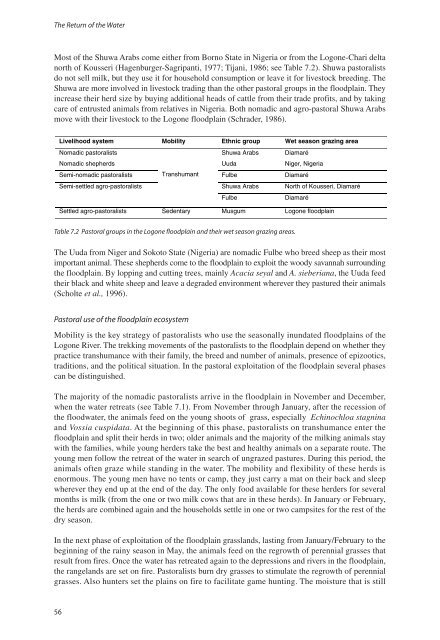The return of the water - IUCN
The return of the water - IUCN
The return of the water - IUCN
Create successful ePaper yourself
Turn your PDF publications into a flip-book with our unique Google optimized e-Paper software.
<strong>The</strong> Return <strong>of</strong> <strong>the</strong> Water<br />
Most <strong>of</strong> <strong>the</strong> Shuwa Arabs come ei<strong>the</strong>r from Borno State in Nigeria or from <strong>the</strong> Logone-Chari delta<br />
north <strong>of</strong> Kousseri (Hagenburger-Sagripanti, 1977; Tijani, 1986; see Table 7.2). Shuwa pastoralists<br />
do not sell milk, but <strong>the</strong>y use it for household consumption or leave it for livestock breeding. <strong>The</strong><br />
Shuwa are more involved in livestock trading than <strong>the</strong> o<strong>the</strong>r pastoral groups in <strong>the</strong> floodplain. <strong>The</strong>y<br />
increase <strong>the</strong>ir herd size by buying additional heads <strong>of</strong> cattle from <strong>the</strong>ir trade pr<strong>of</strong>its, and by taking<br />
care <strong>of</strong> entrusted animals from relatives in Nigeria. Both nomadic and agro-pastoral Shuwa Arabs<br />
move with <strong>the</strong>ir livestock to <strong>the</strong> Logone floodplain (Schrader, 1986).<br />
Table 7.2 Pastoral groups in <strong>the</strong> Logone floodplain and <strong>the</strong>ir wet season grazing areas.<br />
<strong>The</strong> Uuda from Niger and Sokoto State (Nigeria) are nomadic Fulbe who breed sheep as <strong>the</strong>ir most<br />
important animal. <strong>The</strong>se shepherds come to <strong>the</strong> floodplain to exploit <strong>the</strong> woody savannah surrounding<br />
<strong>the</strong> floodplain. By lopping and cutting trees, mainly Acacia seyal and A. sieberiana, <strong>the</strong> Uuda feed<br />
<strong>the</strong>ir black and white sheep and leave a degraded environment wherever <strong>the</strong>y pastured <strong>the</strong>ir animals<br />
(Scholte et al., 1996).<br />
Pastoral use <strong>of</strong> <strong>the</strong> floodplain ecosystem<br />
Mobility is <strong>the</strong> key strategy <strong>of</strong> pastoralists who use <strong>the</strong> seasonally inundated floodplains <strong>of</strong> <strong>the</strong><br />
Logone River. <strong>The</strong> trekking movements <strong>of</strong> <strong>the</strong> pastoralists to <strong>the</strong> floodplain depend on whe<strong>the</strong>r <strong>the</strong>y<br />
practice transhumance with <strong>the</strong>ir family, <strong>the</strong> breed and number <strong>of</strong> animals, presence <strong>of</strong> epizootics,<br />
traditions, and <strong>the</strong> political situation. In <strong>the</strong> pastoral exploitation <strong>of</strong> <strong>the</strong> floodplain several phases<br />
can be distinguished.<br />
<strong>The</strong> majority <strong>of</strong> <strong>the</strong> nomadic pastoralists arrive in <strong>the</strong> floodplain in November and December,<br />
when <strong>the</strong> <strong>water</strong> retreats (see Table 7.1). From November through January, after <strong>the</strong> recession <strong>of</strong><br />
<strong>the</strong> flood<strong>water</strong>, <strong>the</strong> animals feed on <strong>the</strong> young shoots <strong>of</strong> grass, especially Echinochloa stagnina<br />
and Vossia cuspidata. At <strong>the</strong> beginning <strong>of</strong> this phase, pastoralists on transhumance enter <strong>the</strong><br />
floodplain and split <strong>the</strong>ir herds in two; older animals and <strong>the</strong> majority <strong>of</strong> <strong>the</strong> milking animals stay<br />
with <strong>the</strong> families, while young herders take <strong>the</strong> best and healthy animals on a separate route. <strong>The</strong><br />
young men follow <strong>the</strong> retreat <strong>of</strong> <strong>the</strong> <strong>water</strong> in search <strong>of</strong> ungrazed pastures. During this period, <strong>the</strong><br />
animals <strong>of</strong>ten graze while standing in <strong>the</strong> <strong>water</strong>. <strong>The</strong> mobility and flexibility <strong>of</strong> <strong>the</strong>se herds is<br />
enormous. <strong>The</strong> young men have no tents or camp, <strong>the</strong>y just carry a mat on <strong>the</strong>ir back and sleep<br />
wherever <strong>the</strong>y end up at <strong>the</strong> end <strong>of</strong> <strong>the</strong> day. <strong>The</strong> only food available for <strong>the</strong>se herders for several<br />
months is milk (from <strong>the</strong> one or two milk cows that are in <strong>the</strong>se herds). In January or February,<br />
<strong>the</strong> herds are combined again and <strong>the</strong> households settle in one or two campsites for <strong>the</strong> rest <strong>of</strong> <strong>the</strong><br />
dry season.<br />
In <strong>the</strong> next phase <strong>of</strong> exploitation <strong>of</strong> <strong>the</strong> floodplain grasslands, lasting from January/February to <strong>the</strong><br />
beginning <strong>of</strong> <strong>the</strong> rainy season in May, <strong>the</strong> animals feed on <strong>the</strong> regrowth <strong>of</strong> perennial grasses that<br />
result from fires. Once <strong>the</strong> <strong>water</strong> has retreated again to <strong>the</strong> depressions and rivers in <strong>the</strong> floodplain,<br />
<strong>the</strong> rangelands are set on fire. Pastoralists burn dry grasses to stimulate <strong>the</strong> regrowth <strong>of</strong> perennial<br />
grasses. Also hunters set <strong>the</strong> plains on fire to facilitate game hunting. <strong>The</strong> moisture that is still<br />
56<br />
Livelihood system Mobility Ethnic group Wet season grazing area<br />
Nomadic pastoralists Shuwa Arabs Diamaré<br />
Nomadic shepherds Uuda Niger, Nigeria<br />
Semi-nomadic pastoralists Transhumant Fulbe Diamaré<br />
Semi-settled agro-pastoralists Shuwa Arabs North <strong>of</strong> Kousseri, Diamaré<br />
Fulbe Diamaré<br />
Settled agro-pastoralists Sedentary Musgum Logone floodplain












